11
autumn – autumnus
SoundImageSculpture
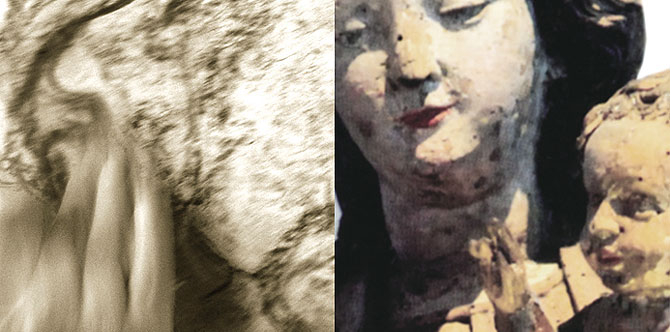
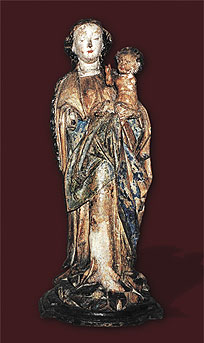
The Madonna of Wintringen
The original furnishings of the late Gothic church in Wintringen included the Madonna figure made of lime wood, which is now exhibited in the museum in the castle church in Saarbrücken. This so-called "Wintringen Madonna" was created around 1480 and is one of the few surviving late Gothic wooden sculptures from the Saar region. According to the stylistic classification, there are references to Lorraine and Upper Rhine art, which was significantly influenced by the important sculptor Nikolaus Gerhaerts von Leyden in this period.
The finely crafted figure of Mary carries the Christ child sitting upright on her left arm. She is clothed in a long robe and cloak, the folds of which develop a strong formal independence, evident, for example, in the part of the cloak that is held shield-like in front of the body and thus represents a counterweight to the Christ child. In structure, it is characterized by an s-shaped sweep. The upper part of the body is inclined backwards, which makes the child stand out very freely and independently. Little of the original colored version of the sculpture remains. The coloration visible today is no longer the original one. Restorative examinations have revealed that the outside of the cloak originally had a poliment gilding, the inside of the cloak was set with azurite, and Mary's robe was set with a two-layered red.
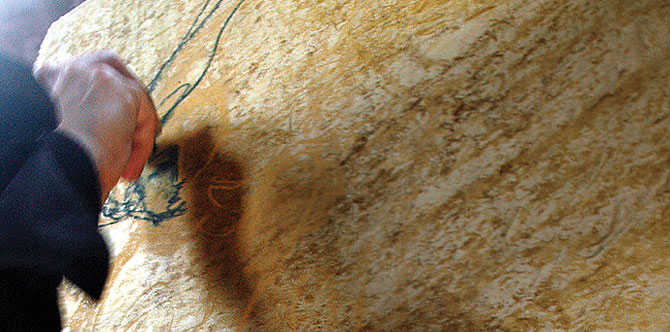
Gracefully and majestically pausing, with a restrained smile on her mask-like features, the Wintringen Madonna proudly presents her son in a folded robe and cloak. Upright and gathered, the child of God appears on her arm with curly hair, blessing hand - blissfully vital and of this-worldly goodness.
Detect threads
The aesthetics of this sculpture and the associated contemporary visual language of its creator were the subject of a present-day discussion on the afternoon of October 1, 2006. The artist group Roland Kunz (compositions, countertenor, keyboard), Bernd Wegener (percussion), Andrea Denis (painting, poetry, drawing), which had come together especially for this event, faced this subject.
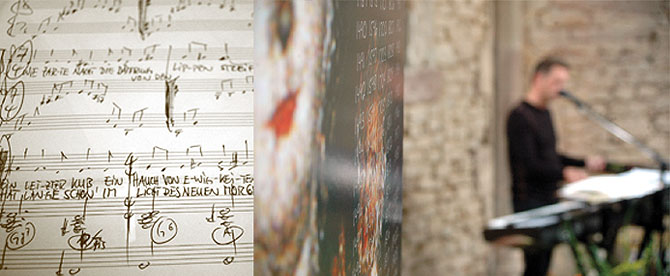
The meaning of the sculpture, as well as the actual location for which the Wintringer Madonna was created, has undergone a great transformation over the centuries. In the juxtaposition of music, poetry and improvised painting, the trio tried to pick up medieval threads again, in order to approach this sculpture. Roland Kunz, Bernd Wegener and Andrea Denise were interested in the experiment of making a historical artistic setting visible and audible. With their interpretations, they attempted to mediate between the artistic statements of the Middle Ages and today's art forms.
Roland Kunz, who brought the formation together for this performance, is known among other things for his compositions that repeatedly scan historical time beams. In his arrangements, time shafts open up, which in places also reach back into the Middle Ages. Through his way of composing and singing, he opens up imaginary, visually powerful worlds for the audience.
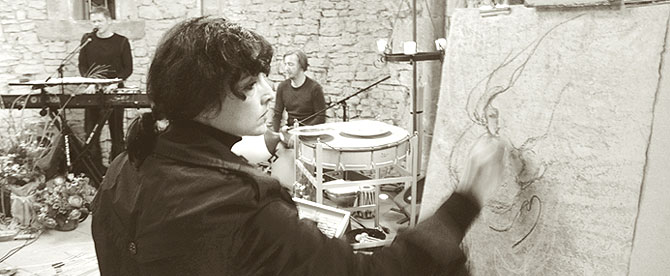
Time I peeled off your surface I lets truth look I exposes essentials I where forbearance I endures in thick layers of life I matures there I of love's power I through deepest night I and all tyranny I your gaze I smilingly I withstood the years I teaches approaching I finding again I holding I like letting go I at the last turning point I of love I overcoming in reconciliation I each other I Time
Image/lyrics: Andrea Denis, October 1, 2006
Decryption
Noticeably, the trio succeeded in dialogue, through a musical and drawing approach - in which the artists brought in their own experiences and individually formal repertoire - to bring back to life to a certain extent what was encoded in the sculpture on site and to transpose it into today's visual and sound language. Collection and movement - composition and improvisation - intuition and understanding thus worked in a dialectical relationship and created points of contact between the times for a moment on this late autumn afternoon in the Wintringer Chapel.
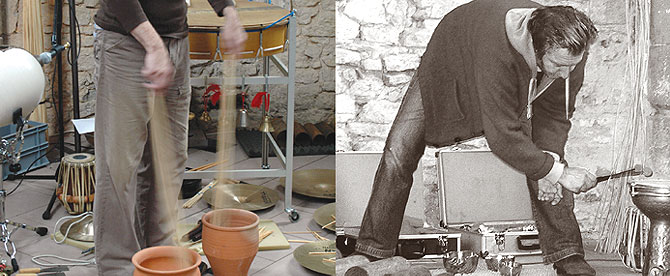

ROLAND KUNZ, SINGER, KEYBOARDER, SONGWRITER, BORN 1960 IN SAARLOUIS I STUDIED MUSICOLOGY, ART HISTORY AND LITERATURE IN SAARBRÜCKEN I VOCAL STUDIES WITH MARIUS VAN ALTENA IN HOLLAND, WITH KARL-HEINZ JARIUS IN FRANKFURT I VARIOUS MASTER CLASSES WITH JOCHEN KOWALSKI, DAVID CORDIER, PAUL ESSWOOD AND OTHERS. I LONGSTANDING PARTICIPATION IN THE COLLEGIUM VOCALE GENT UNDER THE DIRECTION OF PHILIPPE HERREWEGHE AND IN THE BALTHASAR-NEUMANN-ENSEMBLE UNDER THOMAS HENGELBROCK I COLLABORATION WITH TOM KOOPMAN, GUSTAV LEONHARDT AND OTHERS I NUMEROUS INTERNATIONAL TOURS AND CD-RECORDINGS I FOUNDER OF THE SAARLAND FORMATION ORLANDO & DIE UNERLÖSTEN
ANDREA DENIS, BACHELOR OF ARTS (CREATIVE PEDAGOGY AND THERAPY) I LIVES WITH HER FAMILY IN LEBACH AND WORKS THERE AS AN INTERDISCIPLINARY CREATIVE PEDAGOGUE AND ART THERAPIST, FREELANCE VISUAL ARTIST AND POET I IN 1996 ANDREA DENIS FOUNDED "DIE KLEINE KUNSTFABRIK" I IN HER INDIVIDUAL ART SCHOOL WITH HER OWN GALLERY SHE TEACHES CHILDREN, CHILDREN, YOUNG PEOPLE AND ADULTS IN HOLISTIC ART COURSES AND CREATIVE WORKSHOPS I IN ADDITION TO HER POETRY, SHE ALSO WRITES TEXTS FOR ROLAND KUNZ AND HIS FORMATION ORLANDO & DIE UNERLÖSTEN I ANDREA DENIS IS A MEMBER OF THE KUNSTFORUM SAARLOUIS

For the "Book of Hours" KlangBildSkulptur was recorded in cooperation with the AV-Medienzentrum. Camera/Editing/Sound: Hans Bender, Daniel Fischer.
On November 15, 2006, a CD was recorded by ORLANDO (Roland Kunz and Bernd Wegener) in the Wintringer Chapel under the title "Madonna Mystica" with the compositions and texts of the autumn event. This CD also contains a video sequence of the live recording. The CD is available in stores as well as from the organizers.
Info: www.newpast.de and peter.lupp@rvsbr.de
